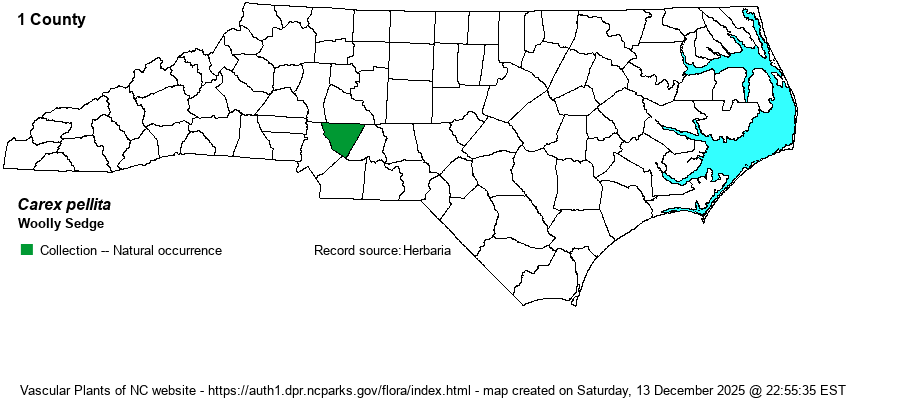| Author | Muehlenberg | |
| Distribution | Known from a single Piedmont collection by Wes Knapp in 2019: Cabarrus County, Suther Prairie.
Newf. to AK, south to NC, KY, AR, TX, and CA; Mex. | |
| Abundance | Very rare. This species has recently been added to the NCNHP database, now tracked as Significantly Rare. | |
| Habitat | Suther Prairie is an open, moist prairie-like area, mown for the past 200 years. In VA, the habitats are "Calcareous fens, wet meadows, depression swamps, and floodplain pools and sloughs; rarely in tidal swamps and wet, probably base-rich flatwoods in the Coastal Plain." (Digital Atlas of the Virginia Flora website). | |
| Phenology | Flowers and fruits May - August. | |
| Identification | Woolly Sedge leaves typically reach 2.5-3.5 feet tall, the flowering culms 2-3 feet. Culms produce 2 narrowly cylindrical female spikes, overtopped by 2 slender male spikes. Leaves are flattish or folded into a M shape (vs. inrolled or involute in C. lasiocarpa var. americana), 2.2-4.5 mm wide (vs. 0.7-2.0 mm wide). | |
| Taxonomic Comments | A synonym is C. lasiocarpa var. latifolia.
The genus Carex is the largest in North America, and among the largest in the world. In temperate and boreal regions, Carex is often the dominant or co-dominant ground layer in many habitats. Seeds (achenes) are valuable food for birds and small mammals, while foliage is used by birds and mammals to make nests and as food by mammals. Species of Carex often look vastly different from one another -- spikes erect vs. drooping, tiny inflorescence vs. whopping, culms leafy vs. naked, perigynia beaked vs. beakless, stems densely bunched vs. single, etc. The genus has been divided into many sections (or groups), based on shared characters; some taxonomists have suggested that these be different genera, but that proves unworkable (so far). All Carex share the feature of a perigynium (an outer covering) which completely surrounds the achene (seed). This covering may fit tightly or loosely (like a small bladder), depending on which group or species. Details of perigynia shape, ornamentation, presence and size of beak, number of striations (or veins) are all important ID features. In recent years Rob Naczi and colleagues have stressed the importance of arrangement of perigynia -- whether spiral (3+ ranks) or distichous (2-ranked) -- and have named a number of new species as well as split off some older synonyms. Therefore, RAB's (1968) key, excellent for its time, can only be used in a general way today. Members of some sections of Carex are difficult to key out (notably Ovales, Laxiflorae, Griseae); this is in part due to variation among individuals of a species, or failings of the key. FNA has drawings of most species and some species may be found in two or more places within a key, to acount for variability. New species to NC, and new to science(!), continue to be found in NC. | |
| Other Common Name(s) | Broadleaf Woolly Sedge | |
| State Rank | S1 | |
| Global Rank | G5 | |
| State Status | SR-P | |
| US Status | | |
| USACE-agcp | | |
| USACE-emp | | |

